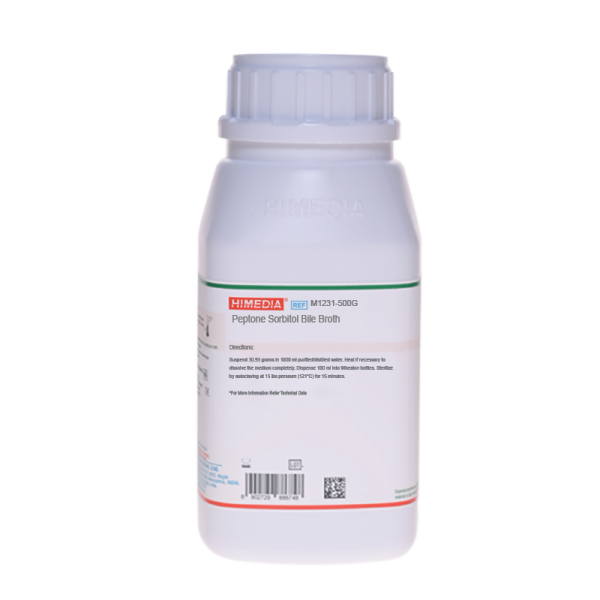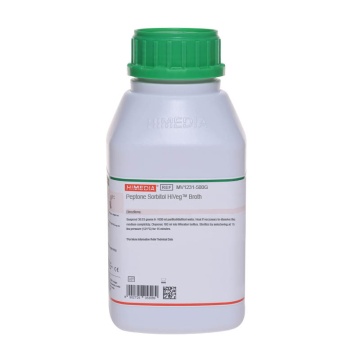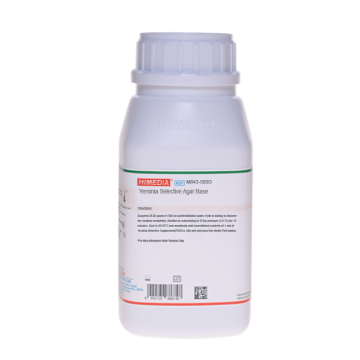 Your enquiry has been submitted
Your enquiry has been submitted
Peptone Sorbitol Bile Broth
Intended Use:
Recommended for identification of Yersinia enterocolitica from dairy products.
Composition**
| Ingredients | Gms / Litre |
|---|---|
| Peptone | 5.000 |
| Sorbitol | 10.000 |
| Disodium hydrogen phosphate | 8.230 |
| Monosodium phosphate | 1.200 |
| Bile salt mixture | 1.500 |
| Sodium chloride | 5.000 |
Final pH (at 25°C): 7.6±0.2
**Formula adjusted, standardized to suit performance parameters
Directions
Suspend 30.93 grams in 1000 ml purified / distilled water. Heat if necessary to dissolve the medium completely. Dispense 100 ml into Wheaton bottles. Sterilize by autoclaving at 15 lbs pressure (121°C) for 15 minutes.
Principle And Interpretation
Yersinia enterocolitica are usually present in finished dairy products as a result of post pasteurization contamination. Swine are recognized as major reservoirs of Y. enterocolitica in nature (2). Yersinia enterocolitica is capable of growth at refrigeration temperatures (3), therefore measures to prevent post pasteurization contamination must be taken to prevent the proliferation of Y.enterocolitica in pasteurized milk. Peptone Sorbitol Bile Broth is formulated as per APHA (6) for the identification of Y. enterocolitica from dairy products.
Peptone Sorbitol Bile Broth contains peptone which provides nitrogenous and carbonaceous compounds, long chain amino acids and growth factors and trace ingredients for the growth of Y. enterocolitica. Sorbitol is a polyhydric alcohol (reduced product of glucose) and an important substrate in biochemical characterization tests for Yersinia. Y.enterocolitica can degrade sorbitol while Yersinia pestis and Yersinia pseudotuberculosis cannot utilize it (6). Phosphates maintain the buffering action of the medium while bile salt mixture inhibit majority of the gram-positive organisms. The pH of the medium is slightly alkaline as Yersinia species are tolerant to dilute alkali (1).
Inoculate 25 grams of samples into 225 ml of Peptone Sorbitol Bile Broth (M1231). Incubate at 10°C for 10 days. After incubation, spread 0.1 ml onto Yersinia Selective Agar Base (M843). Presumptive Yersinia colonies are confirmed by appropriate biochemical test.
Type of specimen
Dairy samples
Specimen Collection and Handling
Inoculate 25 grams of samples into 225 ml of Peptone Sorbitol Bile Broth (M1231). Incubate at 10°C for 10 days. After incubation, spread 0.1 ml onto Yersinia Selective Agar Base (M843). Presumptive Yersinia colonies are confirmed by appropriate biochemical test.
Warning and Precautions :
Read the label before opening the container. Wear protective gloves/protective clothing/eye protection/ face protection. Follow good microbiological lab practices while handling specimens and culture. Standard precautions as per established guidelines should be followed while handling specimens. Safety guidelines may be referred in individual safety data sheets.
Limitations :
- Due to variable nutrient requirements some strains may show poor growth.
- Further biochemical and serological tests must be carried out for further identification.
Performance and Evaluation
Performance of the medium is expected when used as per the direction on the label within the expiry period when stored at recommended temperature.
Quality Control
Appearance Cream to yellow homogeneous free flowing powder
Colour and Clarity of prepared medium Light yellow coloured clear solution without any precipitate
Reaction Reaction of 3.09% w/v aqueous solution at 25°C. pH: 7.6±0.2
pH 7.40-7.80
Cultural Response Cultural characteristics observed after an incubation at 10°C for 10 days.
| Organism | Inoculum (CFU) | Growth | Sorbitol utilization |
|---|---|---|---|
| Yersinia enterocolitica ATCC 27729 | 50-100 | luxuriant | positive reaction |
| Yersinia pseudotuberculosis ATCC 29833 | 50-100 | good-luxuriant | negative reaction |
Storage and Shelf Life
Store between 10-30°C in a tightly closed container and the prepared medium at 15-25°C. Use before expiry date on the label. On opening, product should be properly stored dry, after tightly capping the bottle inorder to prevent lump formation due to the hygroscopic nature of the product. Improper storage of the product may lead to lump formation. Store in dry ventilated area protected from extremes of temperature and sources of ignition. Seal the container tightly after use. Product performance is best if used within stated expiry period.
Disposal
User must ensure safe disposal by autoclaving and/or incineration of used or unusable preparations of this product. Follow established laboratory procedures in disposing of infectious materials and material that comes into contact with sample must be decontaminated and disposed of in accordance with current laboratory techniques (4,5).
Reference
- Aulisio C. C. G., Mehlman I.J. and Sanders A. C., 1980, Appl. Environ. Microbiol., 39:135.
- Doyle M.P., Hugdahl M.B., Taylor S. L., 1981, Appl. Environ. Microbiol. 42:661-666
- Francis D. W., Spaulding P.L.,Lovett J., 1980, Appl. Environ. Microbiol. 40:174-176
- Isenberg, H.D. Clinical Microbiology Procedures Handbook 2nd Edition.
- Jorgensen, J.H., Pfaller, M.A., Carroll, K.C., Funke, G., Landry, M.L., Richter, S.S and Warnock., D.W. (2015) Manual of Clinical Microbiology, 11th Edition. Vol. 1.
- Wehr H.M. and Frank J. H., 2004, Standard Methods for the Microbiological Examination of Dairy Products, 17th Ed., APHA Inc., Washington, D.C.
| Product Name | Peptone Sorbitol Bile Broth |
|---|---|
| SKU | M1231 |
| Product Type | Regular |
| Physical Form | Powder |
| Origin | Animal |
| Packaging type | HDPE |
| References | 1. Doyle M.P., Hugdahl M.B., Taylor S. L., 1981, Appl. Environ. Microbiol. 42:661-666 |
| Customized Product Available | No |








